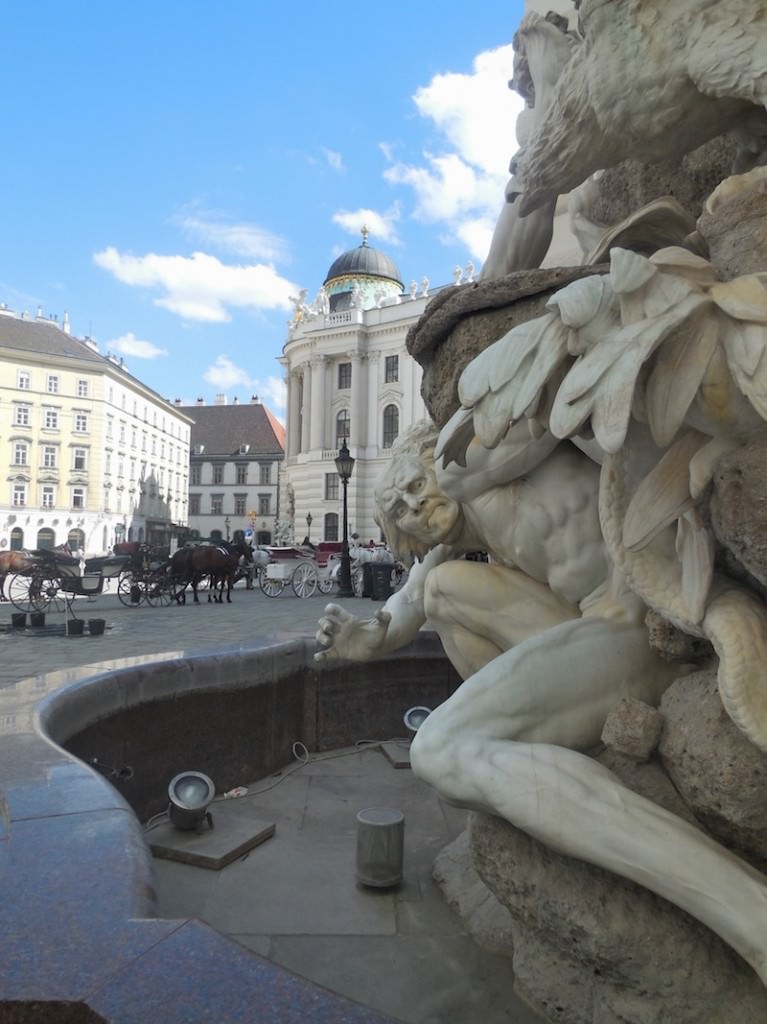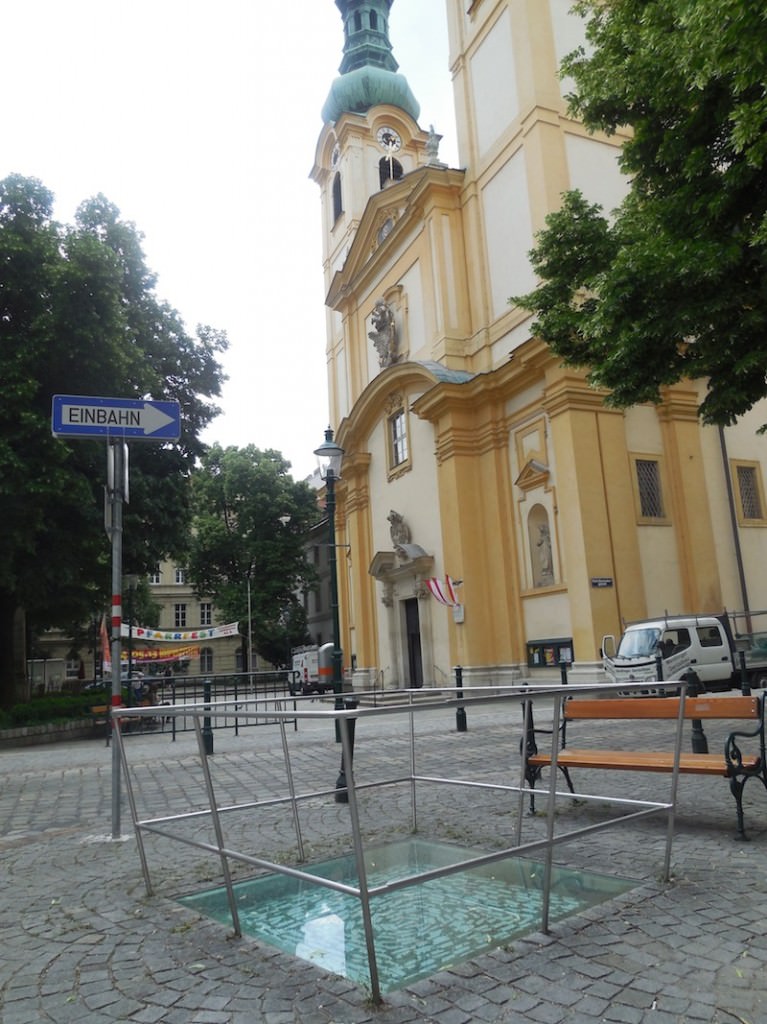The more you know about Vienna’s history, the more memorable your visit will be. I worked at the American International School in Vienna over two decades ago and returned as a tourist last year.
Twenty-five years ago, one book and one movie opened my eyes to the darker side of Vienna. If you can, read A Nervous Splendor: Vienna 1888/1889 by Frederic Morton and watch “The Third Man,” starring Orson Wells. They will teach you that Vienna is a much darker and more complicated city than her monuments might suggest.
Many of the dark sights of Vienna are covered by the Vienna Pass – read our post on whether the pass is worth it or not here.
Loss of Empire
Start with the reason Vienna is packed with museums and palaces in the first place. The Hapsburg Empire collapsed in 1918 after 600 years, and the Viennese have never really gotten over it.
We were there in 1989 when the funeral procession of 96-year-old Empress Zita, the last Hapsburg on the throne, trundled through the streets past 20,000 spectators, some openly weeping. She is buried in the Kaisergruft (Imperial burial vault) in the Capuchin Church along with 148 other Habsburgs.
The church is just a short walk between the Opera House and St. Stephens Cathedral and well worth your time. Stand before the truly sad tombs of Franz Joseph and his family: his wife Elisabeth (“Sisi”) was assassinated and Rudoph, his son, committed suicide with his teenage mistress. The book A Nervous Splendor recounts the history of this suicide and the neurotic world in which it took place.
World War II
The next loss falls within living memory. From the Capuchin Church, walk towards St. Stephen’s Cathedral with its gaudy roof. This roof burned and collapsed in the Allied bombings of 1945. It was rebuilt one tile at a time with individual donations in 1952, despite the rubble not yet cleared from the city center. Stand in front of this magnificent cathedral, surrounded by vibrant, artful buildings, but imagine a very different recent past.

This roof caught fire when looters burnt nearby shops and sparks ignited the roof. An Allied bomb fell into the church the next day.
A movie will bring that period vividly to life. The brilliant noir thriller The Third Man shows in Vienna at the Burg Kino (movie theater on the Ringstrasse) on Tuesday, Friday, or Sunday (also available on Netflix). Afterwards take the walking tour of the film’s settings and follow the amoral smuggler Harry Lime (Orson Wells) through the ruined city. The frothy tourist Vienna of today falls away and you are transported instantly back to those bitter postwar years.
Vienna was split, like Berlin, between the Russian and Allied sectors until 1955. If you go to the Belvedere Palace, you’ll pass by Schwarzenbergplatz featuring a tall column with a “heroic” Russian soldier known to older Viennese as “The Unknown Plunderer.”
Heldenplatz is the main square in front of the Hofburg Palace; every tourist walks through it to the Treasury. But in March, 1938 Hitler’s storm troopers and tanks rolled into Heldenplatz under Anschluss (union with the German Reich), cheered by 200,000 Austrians waving Nazi flags. Two more examples of history hidden in plain sight.
Death in Vienna
A streak of fascination with death runs through Viennese culture, and suicide has a deep history and much less social stigma than elsewhere. Crown Prince Rudolph is the most famous example, but Vienna’s suicide rate was the highest in Europe towards the end of the Hapsburg Empire. Freud named this penchant “the death wish.”
A couple of sights can peel back the curtain on this fascination for even the casual tourist. Schone Leiche means ‘beautiful corpse’ and for the Viennese, a proper sendoff was essential. The Funeral Museum behind the Belvedere Palace is both macabre and charming. Where else could you find displays like a coffin equipped with a bell in case your loved one wasn’t entirely dead? An urn in the shape of a soccer ball?
The Zentralfriedhof is one of the largest cemeteries in the world, and the #71 bus travels there from the Opera House. In fact, “Taking the 71” is a euphemism for “dying.” Zentralfriedhof is strictly divided by religion and I distinctly remember in 1989 the segregated Jewish section being shockingly overgrown; after all, there was nobody left to tend the graves. Of 185,000 Jews in Vienna in 1938, only about 7,000 remain today; 60,000 died in the camps.
The Destruction of Vienna’s Jews
The ugliest current running through Viennese history is the near extinction of its Jewish community. The glorious explosion of culture and thought during the last 50 years of the Habsburg Empire was largely due to the Jewish intelligentsia: Freud, Schonberg, Mahler, Wittgenstein, but by 1938 this flowering had been totally destroyed. Several important sights reflect this history either explicitly or just below the surface.
Just behind the Opera House is the Judenplatz memorial. On Kristallnacht (Night of Broken Glass in November, 1938), all Vienna’s synagogues except one were destroyed; the heartbreaking statue of an elderly Jew scrubbing the street on his hands and knees commemorates this humiliation. However, oblivious tourists would sometimes sit on his back like a park bench or stand by while their dogs raise their hind legs. Even today deliberate anti-Semitism is far from dead. In June, 2012 Jewish graves in the Zentralfriedhof were desecrated. Even today, armed guards patrol outside the Stadttempel, Vienna’s main synogogue.
Wander into the 9th District just outside the Ringstrasse, turn onto Berggasse and look for #19. This was Freud’s home and office until the Nazis forced him to leave in June, 1938. We lived just down the street across from the lovely Baroque church Servitenkirche and used to walk up Berggasse to catch the school bus.
We regularly passed starry-eyed Freudians standing on the sidewalk gazing up at their hero’s windows. They stood in front of the Tabak Trafik (tobacco shop) where Freud used to buy the cheap cigars he smoked constantly and which eventually killed him.
I revisited Servitenkirche this trip and came across a new and heartbreaking memorial to murdered Jews. A pit has been built into the ground on a corner of the church square with a display of the house keys and names of the Jews who once lived in the quarter.
Equally chilling, our second apartment in Vienna had once been occupied by a Jewish furrier and his family until they were dispossessed by Nazi officers in 1939. Tourist or resident alike stumble over this history, if they know where to look.

In 1938 over half the residents of the 9th District were Jews. One aim of the project is to contact any surviving descendants.
If you have a time for a day trip or are on your way to Salzburg, Melk, or Hallstatt, visit Mathausen, the concentration camp eerily planted in the idyllic Austrian countryside. Of all the concentration camps in Europe, I believe this is the most chilling. Jews and dissidents were worked and starved to death at the granite quarry.
Climb the long “Stairway to Death” from the depths of the quarry, but imagine carrying stone blocks weakened from virtually no food. At the top of the these stairs, doomed prisoners saw picturesque Austrian farmhouses with tidy woodpiles and red impatiens in window boxes, all very gemutlich (cozy), but the contrast even more horrifying.
It is entirely possible to enjoy Vienna’s delights without a thought to the ugly currents swirling through her history. Strauss waltzes,Apfel Strudel mit Schlag (whipped cream), Mozart, the Winter Riding School are all intoxicating pleasures, of course. But Vienna occupies a pivotal place in the upheavals of the 20th century and the more background you bring, the richer your experience when visiting this great city. So do a bit of homework and do not be afraid to explore the darker side of Vienna.
Kathy Fritts is a retired school librarian who has lived and worked in six different countries. Now she travels for fun and writes to educate and encourage readers to take a chance and enrich their lives by traveling.





jane
Wednesday 18th of November 2015
Hello, are you a descendent of Stephen Fogarty,? I found his signature several times in my British father's guest book in 1951/52
Hamish Healy
Friday 11th of April 2014
Vienna is a beautiful city laden with history and culture all its own. Perhaps because of this, some people have an impression that it’s an “old” city. Not too many young people would have Vienna in their top-ten-places-to-visit list.
Andrea and John
Tuesday 18th of March 2014
Thanks for this interesting post - I loved Vienna but wasn't aware of much of this history